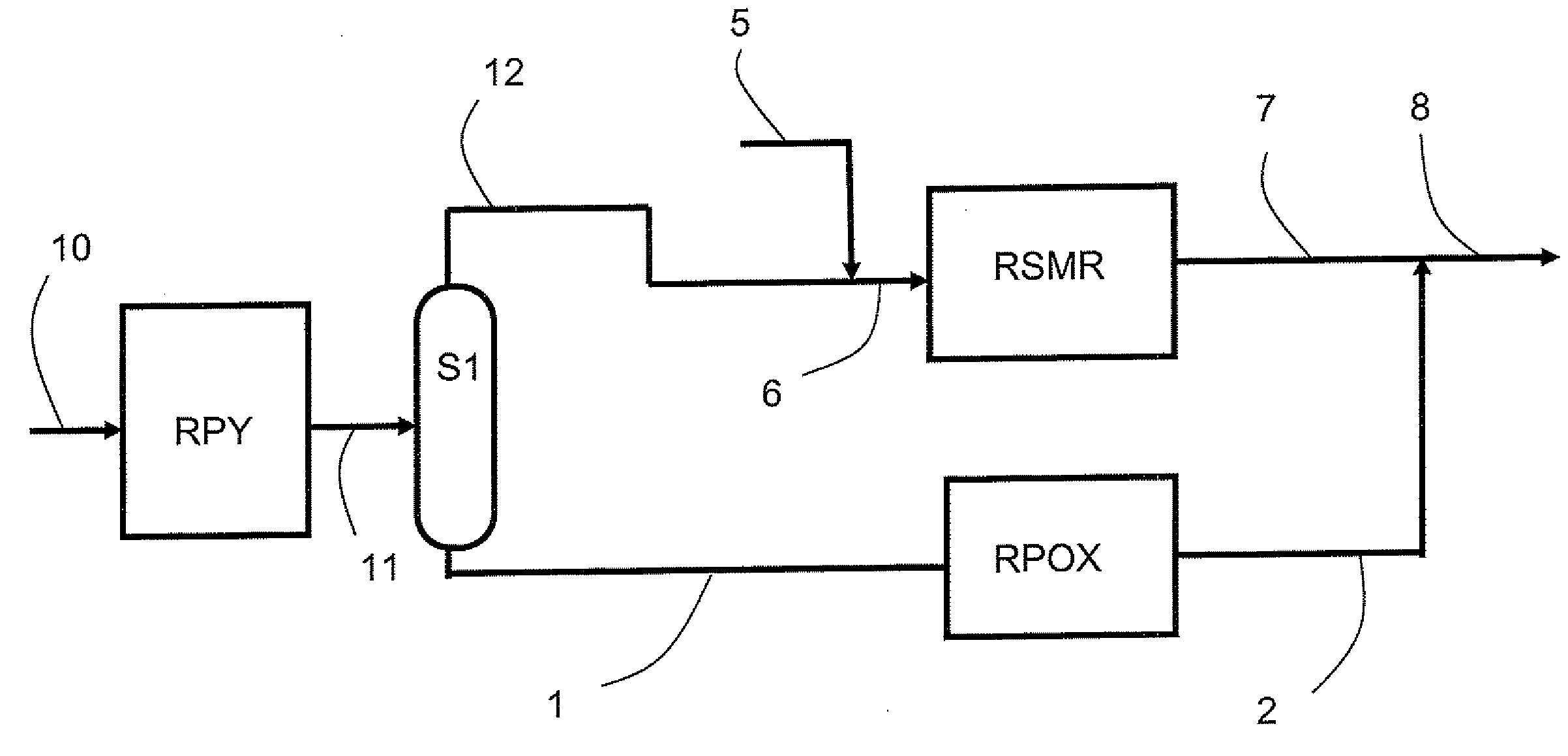Method of producing synthetic gas with partial oxidation and steam reforming
a technology of partial oxidation and synthesis gas, applied in the field of process for producing synthesis gas, can solve the problems of incompatibility with heavy carbon-containing feedstocks that contain impurities such as carbon, petroleum residues or biomass, incompatible with heavy carbon-containing feedstocks, and inability to use light feedstocks, etc., to achieve the effect of adding complexity or a lack of reliability, reliable and simple installation
- Summary
- Abstract
- Description
- Claims
- Application Information
AI Technical Summary
Benefits of technology
Problems solved by technology
Method used
Image
Examples
example 1
According to the Invention
[0071]A unit for producing synthesis gas for implementing the process according to the invention treats wood chips. Wood in the form of small chips (for example between 2 and 6 mm), having a moisture level of 40% by weight, is first dried, for example in a drier with a conveyor belt or else a fluidized bed. After drying, the wood flow rate is 18,160 kg / h, including 16,160 kg / h of dry material and 2,000 kg / h of residual moisture. The wood is stored in a pressurized can, for example between 3 and 3.2 MPa, then sent directly to the partial oxidation reactor RPDX, also supplied by 10,590 kg / h of oxygen and 2,000 kg / h of additional water vapor, also used for the transport of wood to the reactor. The effluent at the outlet of the reactor RPDX is a synthesis gas with an H2 / CO ratio such that H2 / CO=0.67 with a gaseous flow rate of 30,590 kg / h, a temperature of 1400° C., and under a pressure of 2.9 MPa. 160 kg / h of solid products, essentially carbon-poor ashes, also...
example 2
According to the Invention
[0079]The same partial oxidation of biomass as in Example 1 is carried out but, contrary to Example 1, the vapor-reforming feedstock is increased by means of a suitable quantity of external methane so as to obtain the H2 / CO ratio of 2.15 by mixing the two synthesis gases without carrying out the conversion of CO into vapor. The results are presented in Tables 4, 5 and 6.
TABLE 4RPOXRPOXQuenching onFEED-EFFLU-the RPOXSTOCKENTEFFLUENTBiomass: Dry Material kg / h16,160H2O Moisture kg / h2,000Oxygen10,590H2O kg / h2,0006,973Pressure MPa3Temperature ° C.1,40025Flow Rate kg / h (Gas)30,590H2 % by Vol.21.4CO % by Vol.32H2O % by Vol.32.6CO2 % by Vol.14C1 % by Vol.0H2 / CO Vol.0.67Ashes kg / h160
TABLE 5RSMRRSMRFEED-EFFLU-SMRSTOCKENTFuelC1 (External Feedstock)4,248714CO / H2 / CO2 / H2O (Residual) of the Top03,684Gas Effluents kg / h; Ex FT top gas kg / h(Fuel)Ex FT C1-C4 kg / H (Fuel)02,907Ex FT Naphtha kg / h (Recycling)1,674Ex HDK C1-C4 kg / h (Recycling)80Ex HDK Naphtha kg / h (Recycling)625H2...
PUM
| Property | Measurement | Unit |
|---|---|---|
| temperature | aaaaa | aaaaa |
| temperature | aaaaa | aaaaa |
| temperature | aaaaa | aaaaa |
Abstract
Description
Claims
Application Information
 Login to View More
Login to View More - R&D
- Intellectual Property
- Life Sciences
- Materials
- Tech Scout
- Unparalleled Data Quality
- Higher Quality Content
- 60% Fewer Hallucinations
Browse by: Latest US Patents, China's latest patents, Technical Efficacy Thesaurus, Application Domain, Technology Topic, Popular Technical Reports.
© 2025 PatSnap. All rights reserved.Legal|Privacy policy|Modern Slavery Act Transparency Statement|Sitemap|About US| Contact US: help@patsnap.com



